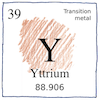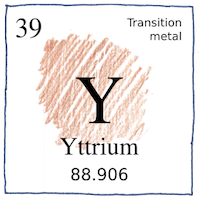Åbo, Stockholm—Johan Gadolin,
Carl Gustaf Mosander
elements

|
Yttrium
In 1792, Carl Axel Arrhenius, a student of Berzelius, and a promoter of the theories of Antoine Lavoisier, now a lieutenant in the Artillery, found a black and unusually heavy mineral thought it might contain tungsten and sent it to Johan Gadolin. He named it ytterbite. Johan Gadolin, a student of Torbern Bergman, and also a promoter of the theories of Antoine Lavoisier, now a professor without pay at Åbo, worked on the ytterbite from Arrhenius. In 1794 he announced it contained a new “earth,” an oxide of the first known rare earth. He named it ytterbia. Forty-nine years later, in 1843, Carl Gustaf Mosander, also a student of Berzelius, now holding Berzelius’s position in the Karolinska Institute, found that Gadolin’s ytterbia (now called yttria) was actually a mixture of three oxides which he named yttria, erbia, and terbia.
Named after Ytterby
Carl Axel Arrhenius named his mineral ytterbite, after Ytterby, in Sweden. Martin Klaproth renamed it gandolinite, after Johan Gadolin. Johan Gadolin named the new oxide ytterbia, after Arrhenius’s name for the mineral. Anders Gustaf Ekeberg shortened the name to yttria. Carl Gustaf Mosander separated yttria into three oxides. a colorless oxide retaining the name yttria, a yellow oxide erbia, and a rose oxide terbia. Nils Johan Berlin couldn’t find the yellow oxide so named the rose oxide erbia. Marc Delafontaine found the yellow oxide and named it terbia. Jean Charles Galissard de Marignac separated erbia into two oxides, erbia and ytterbia. Nilson separated Marignac’s ytterbia into ytterbia and scandia. Georges Urbain separated Nilson’s ytterbia into neoytterbia and lutecia.
Atomic number 39
Yttria helps give the red color to television and computer screens. Yttrium compounds are catalysts for making plastics. Yttrium metal is used on electrodes of spark plugs in automobile engines. Yttrium compounds are used to make infrared lasers. Yttrium barium copper oxide is a low-temperature superconductor.
Rare earths
Seventeen rare earth elements—yttrium, scandium, and the lanthanides—all heavier than iron but having decreased ionic radii which makes them difficult to separate and likely to be found together in minerals, are the introverts of the elements, not extroverts like carbon and oxygen, but like the dirt that green things grow in.



Eventually, ten new elements were separated from Gandolin’s yttria—yttrium, erbium, terbium, ytterbium, gadolinium, thulium, holmium, scanium, dysprosium, and lutetium. The place name Ytterby in Swedish means “outer village.”
See also in The book of science:
Readings in wikipedia:
Other readings: